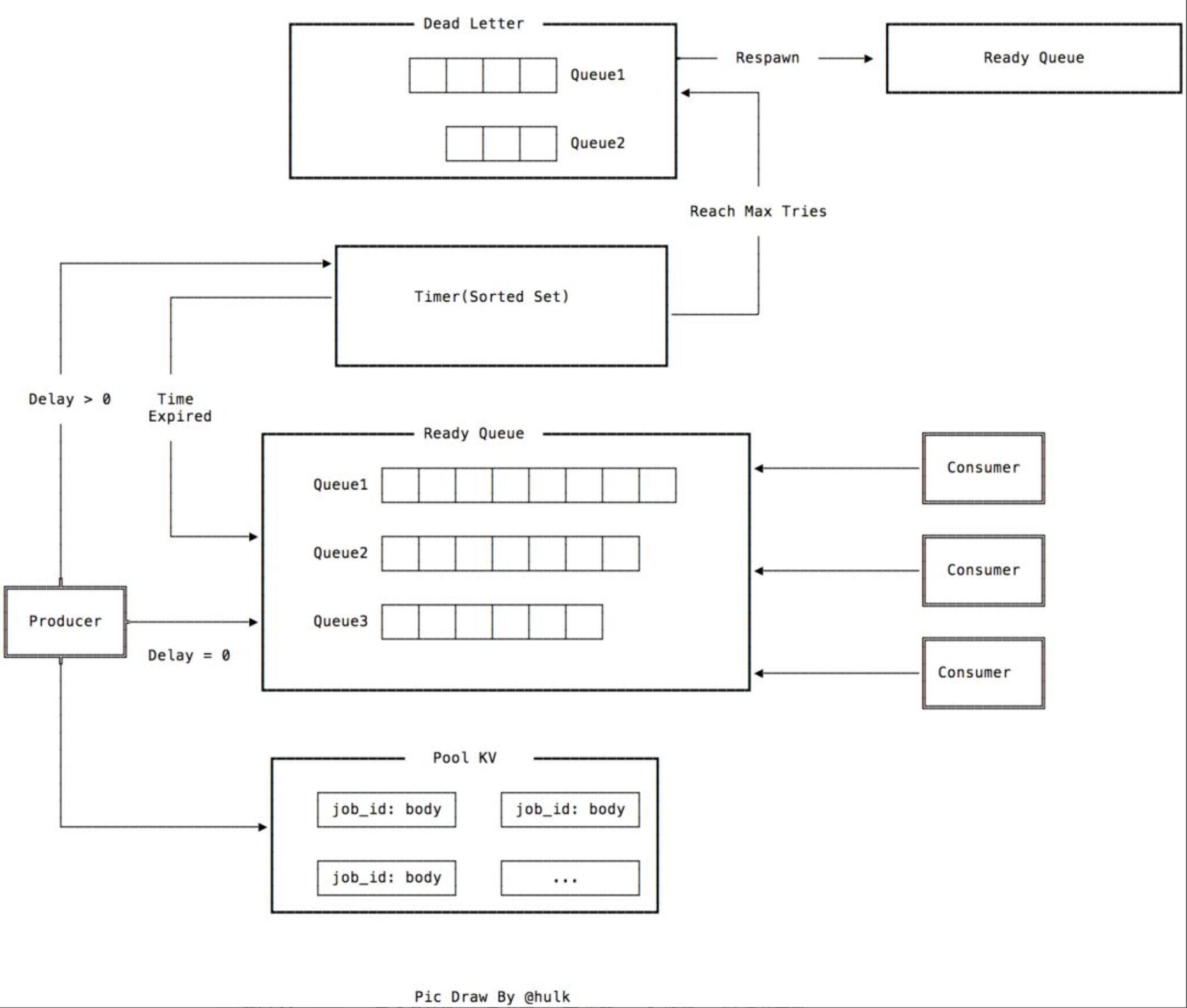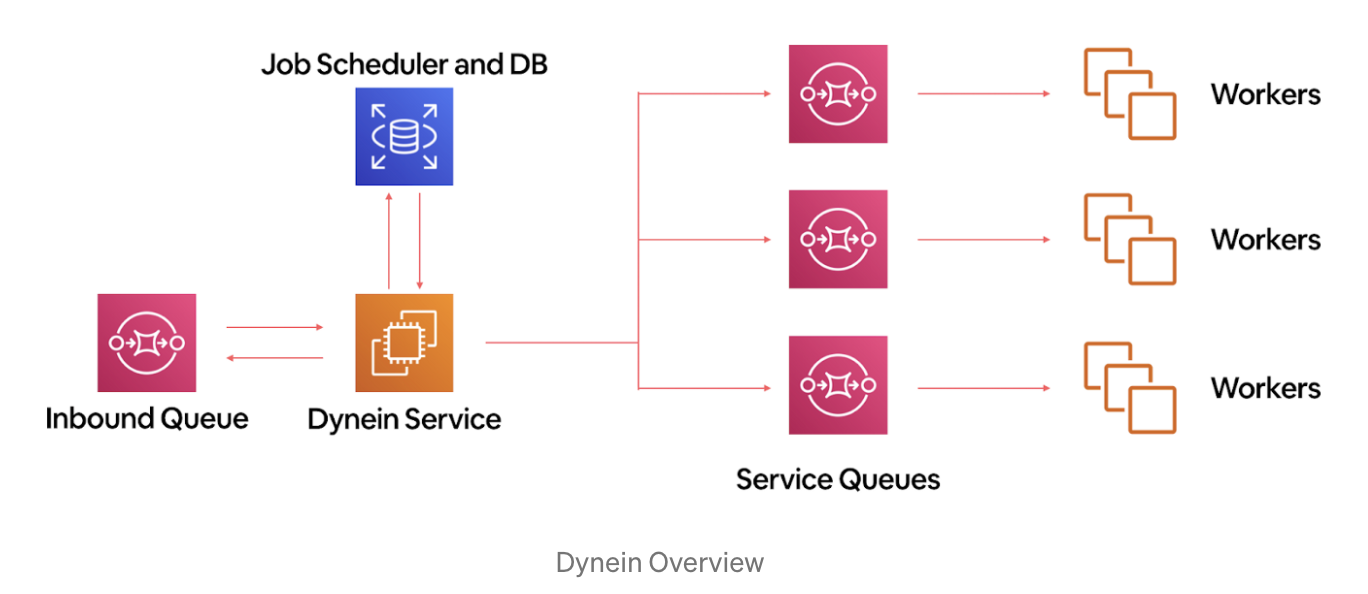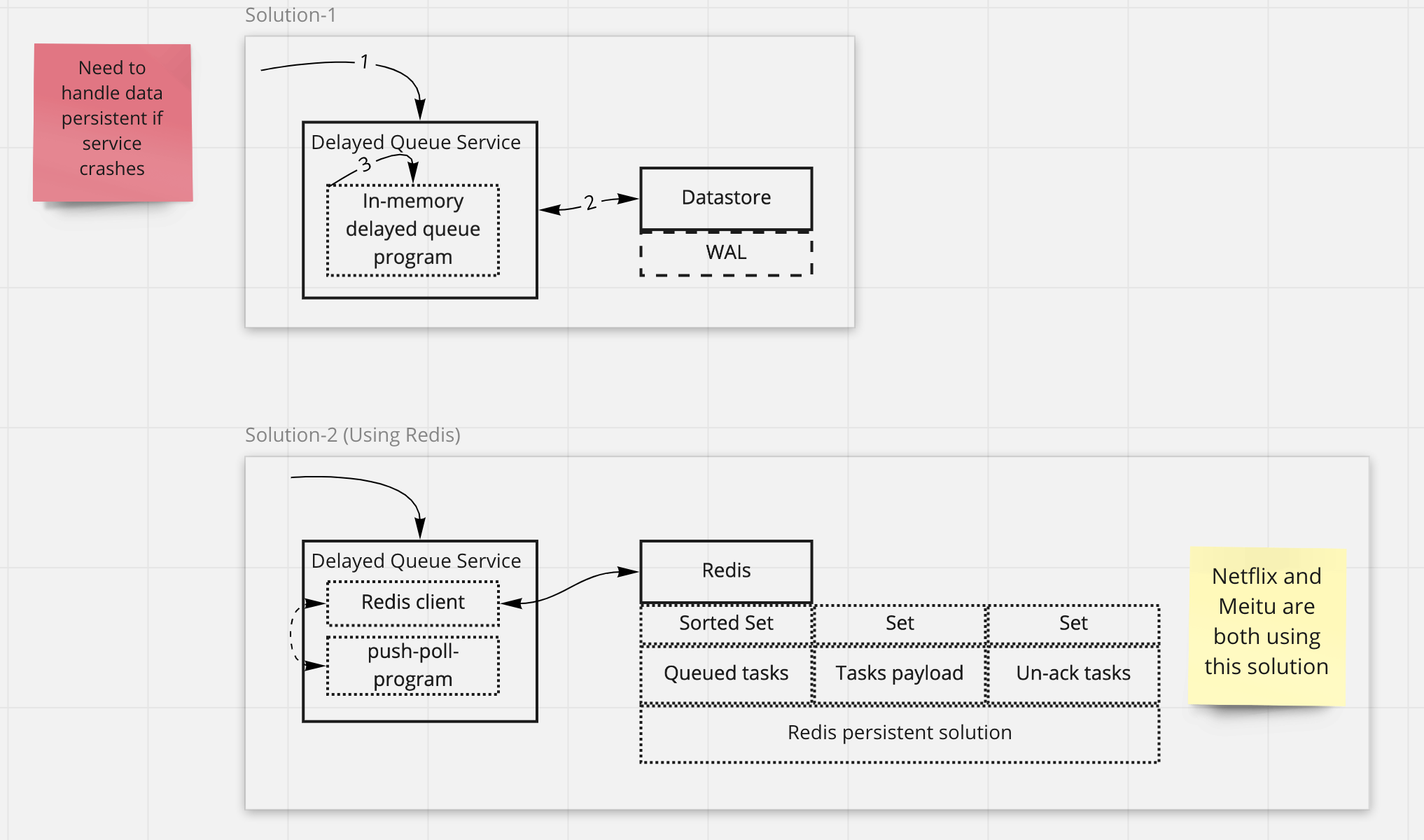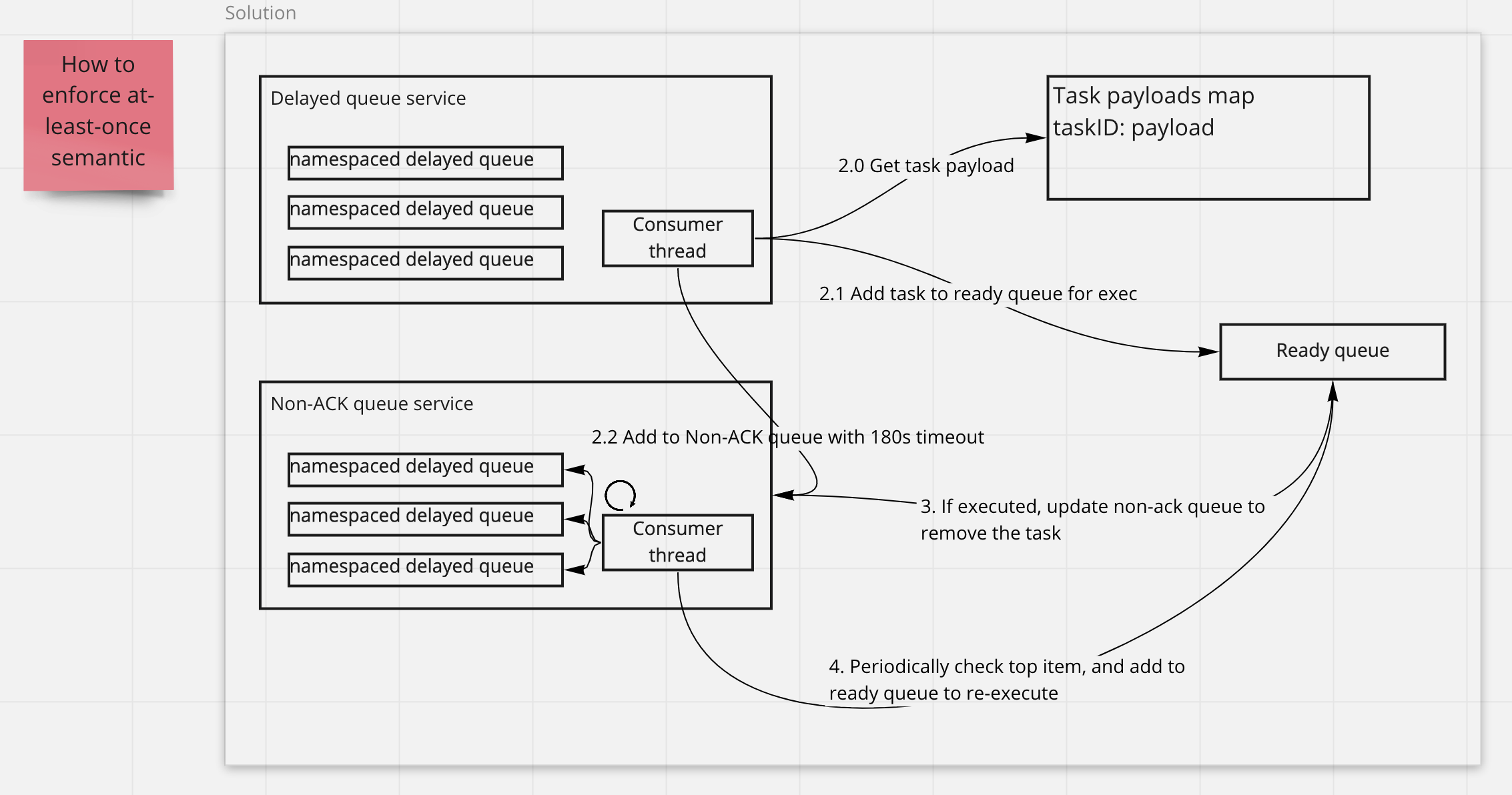Design a distributed delayed job queueing system
Requirement
Functional requirement
- In a system with the limited resources, we want to put the task which uses intensive compute resource to a job queue for later execution. Or we want the system to execute a job based on its execution time configuration(Send email/notification at Mar 20th 2021 17:00).
- The job needs to be executed at least once with a maximum retry.
- The job should be able to be unscheduled at any time.
Non-functional requirement
- Reliability: No data lost on system fails or restarts.
- Scalability: Allow horizontal scaling with the growth of capacity.
- Isolation: The system provides a shared service that all applications might use. A single application’s queue being overwhelmed should not affect other job processing.
- Timing accuracy: The job needs to be executed on time. Or P95 is less than 10 seconds.
Data model
Task
type Task struct {
ID string // globally unique task ID
Namespace string // the namespace of a task to provide queue isolation
Delay Time // the delay when task needs to be executed
Score int // the score which could be used to calculate the priority other than time
Topics string // for consumers to subscribe
Payload Payload
}
type Payload struct {
CallbackFuncName string // for consumers to invoke the callback function
Args []string // args pass to the callback function
}
Delayed queue APIs
type DelayedQueue interface {
Push(task Task) error
Poll() error
Delete(taskID string, namespace string) error
Update(task Task) error
}
# Create a new delayed task
curl -X PUT https://endpoint/v1/delayedqueue \
-d {id: 1, namespace: default, delay: 5s, score: 10, payload: {...}}
# Update a task
curl -X POST https://endpoint/v1/delayedqueue \
-d {id: 1, namespace: default, delay: 15s, score: 10, payload: {...}}
# Delete a task
curl -X DELETE https://endpoint/v1/delayedqueue \
-d {id: 1, namespace: default}
# Get a task status
curl -X GET https://endpoint/v1/delayedqueue/status \
-d {id: 1, namespace: default}
Architecture
Meitu delayed queue architecture

Airbnb architecture

How to handle data persistence

How to enforce at-least once semantics

How to implement un-schedule feature
taskIDcould globally identify a task- The client will send
taskIDfor un-schedule or deletion - Priority queue uses O(n) on average to delete an element; Sorted set(BST based) uses O(log(n)). If we want to speed up
the deletion/update to the queue element, we could build up an index. Key could be the
taskIDand the value could bepointer to queue element. Here is the trade-off between space and performance. If building index, there will other problem like “how to persist the index”
How to prevent noisy tasks to occupy all the queue resource (isolation)
- Service A has way too many delayed tasks than Service B, so Service B’s tasks will starve.
- Service A has too many long delayed tasks (1 month), the performance of other operations decrease.
How to handle the scaling

- node-1 reaches the capacity
- control plane detects that from
metrics api - control plane create a new service instance on node-2 and node-3 if necessary
- control plane directs the incoming task scheduling requests to different service instances
- the same data persistent logic applies at the bottom
The control plane looks like a LB/ingress controller which provides the round-robin or other advanced L7 routing rules.
How delay queue is implemented in Java’s implementation
- PriorityQueue: Hold the objects on a sorted order (sort by expiration time)
- ReentrantLock: Handle the concurrent read-write problem
- Multiple producer threads and consumer threads
- Leader-follower pattern for consumer threads: Improve the performances (code inline comments)
How producer adds objects
/**
* Condition signalled when a newer element becomes available
* at the head of the queue or a new thread may need to
* become leader.
*/
private final Condition available = lock.newCondition();
/**
* Inserts the specified element into this delay queue.
*
* @param e the element to add
* @return {@code true}
* @throws NullPointerException if the specified element is null
*/
public boolean offer(E e) {
final ReentrantLock lock = this.lock;
lock.lock();
try {
q.offer(e);
if (q.peek() == e) {
/*
if the newly added object becomes the top element:
- the old leader who is waiting for the second element(now) needs to be reset. we need a new leader to take
the current top element.
- available.signal() wakes up the next waiting thread, tells it there is an element might expire now.
*/
leader = null;
available.signal();
}
return true;
} finally {
lock.unlock();
}
}
How consumer poll objects
/**
* Retrieves and removes the head of this queue, waiting if necessary
* until an element with an expired delay is available on this queue.
*
* @return the head of this queue
* @throws InterruptedException {@inheritDoc}
*/
public E take() throws InterruptedException {
final ReentrantLock lock = this.lock;
lock.lockInterruptibly();
try {
for (;;) {
E first = q.peek();
if (first == null)
// if current thread sees the current top object is null, then a) release lock, b) step away to wait
// when it awakes, it will reacquire the lock and continue
available.await();
else {
// if current thread sees the current top is NOT null
long delay = first.getDelay(NANOSECONDS);
if (delay <= 0L)
// and current top object expires, then just return it to caller
return q.poll();
// otherwise the current thread needs to step away and wait
first = null; // don't retain ref while waiting
if (leader != null)
// if current thread sees there is already a leader waiting in the queue to process the current
// top object, then it steps away to wait
available.await();
else {
// otherwise promote current thread to be leader who has privilege to handle the current top object
Thread thisThread = Thread.currentThread();
leader = thisThread;
try {
// current thread becomes the leader and just need to wait "delay" amount of time, then it could
// awake and proceed. When it awakes the lock will be reacquired so that no other threads could
// enter, and it will continue to the beginning of the loop to take the top object
available.awaitNanos(delay);
} finally {
// if current thread is leader and it is about to process the current top object, resets leader
// so that other threads have chance to work
if (leader == thisThread)
leader = null;
}
}
}
}
} finally {
if (leader == null && q.peek() != null)
// if current leader has processed the top object and the next top element is NOT null, notify next waiting
// thread to process it
available.signal();
lock.unlock();
}
}
What is leader-follower pattern for consumer threads and why needs it
How multiple consumers check if the top object has expired?
- All consumers check the top object periodically
- CPU inefficiency caused by loop
Questions
- If we have multiple tasks expired at the same time, will one by one dequeue has performance issue?
Caveat
- SQS maximum delay time is 15 minutes
Conclusions
- Using namespace to provide the isolation and using different queues for different business logic
- Using three collections
- a priority queue or sorted set for scheduling (delay or score info used by sorting)
- a map for task payload
- a priority queue or sorted set for non-ack task metadata(this is to track requeue or fail)
- Using wait/notify instead of using thread looping to check if task is ready
References
- How airbnb implements delayed queue
- How netflix implements delayed queue
- How Meitu LMSTFY implements delayed queue
- https://github.com/airbnb/dynein
- https://www.baeldung.com/java-delay-queue
- https://javapapers.com/java/java-blockingqueue/
- https://javapapers.com/java/java-delayqueue/
- https://github.com/openjdk/jdk/blob/master/src/java.base/share/classes/java/util/concurrent/DelayQueue.java
- https://redislabs.com/ebook/part-2-core-concepts/chapter-6-application-components-in-redis/6-4-task-queues/6-4-2-delayed-tasks/
- https://github.com/bitleak/lmstfy/
- https://juejin.cn/post/6844904150703013901
- https://tech.youzan.com/queuing_delay/
- How Timer wheel works
- Reinventing timer wheel